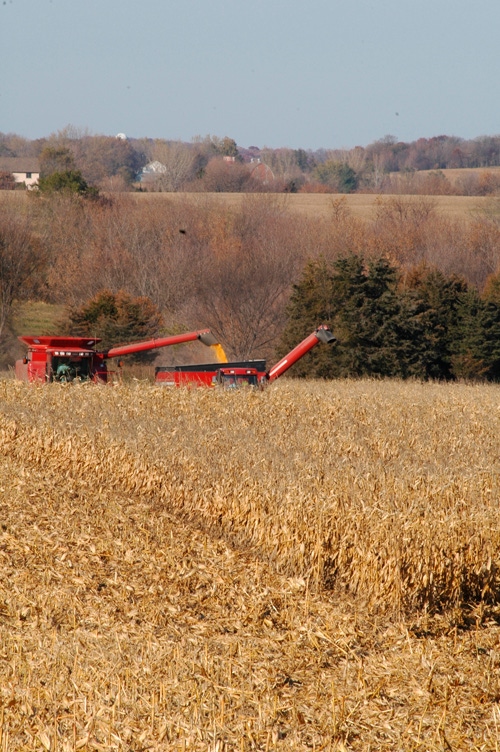October 5, 2010

As of Sept. 27, nearly 91% of Iowa’s corn rates are “safe from frost” according to the USDA-NASS report indicating the majority of the crop is physiologically mature (R6). The crop’s development is five days ahead of normal, 68% mature, and dramatically outpaces the 43% mature recorded in 2009 for the same week.
Drydown remains the last major in-field growing season process after the grain reaches black layer. The grain, although still connected to the cob, is disconnected physiologically from the plant because of the abscission or black layer; no further exchange of either nutrients or water between the cob and the kernel occurs.
Although corn is harvested at higher grain moistures for silage and seed corn, ideal harvest moistures for field corn range from 15% to 20% and higher. Delaying harvest until corn dries to 15-20% will save considerable artificial drying costs. Yet as corn dries, hybrids and fields with poor stalk quality become increasingly susceptible to stalk lodging. Harvest efficiency decreases rapidly and harvest losses increase in fields with lodged corn.
Grain usually dries at a linear rate that varies depending on weather and other factors. For example, wet and cool weather slows drying. We’ve seen drydown rates less than 0.3%/day. On the other hand, warm, dry weather speeds drying; kernels can lose up to 1% moisture/day with excellent drying weather. Considering that corn at maturity has about 30% moisture content it could easily take two or more weeks for grain moisture to drop to 20%.
Early research with inbreds by Iowa State University documented drydown rates of 0.5-0.6% grain moisture loss/day when evaluated from late August (dent stage, R5) through October. Two years of research by University of Nebraska in the mid-1990s found a range from 0.60% to 0.64% moisture loss/day. In that study, four hybrids – including both conventional and transgenic – did not differ in their drydown rates. More recent data from University of Wisconsin matched those of the Nebraska research; grain lost about 0.66% moisture/day.
Factors related to grain drydown
Bob Nielsen, Extension agronomist at Purdue University, summarized field drydown in a recent web article. We’ll discuss some of his ideas here and make a few additions.
Air temperatures – heat units – largely drive in-field grain drydown. As fall progresses, day length shortens and temperatures drop. As this occurs grain moisture normally stabilizes around 15-20%.
Although weather – mainly temperature and humidity – is the main driver of grain drydown, we must also factor in hybrid characteristics, namely ear and husk characteristics. Modern hybrids characteristically have fewer husks and delayed husk senescence relative to older hybrids. Both of these contribute to faster drydown.
Nielsen writes that if hybrids differ by a day of relative maturity, they will typically vary by about 0.5% grain moisture if planted on the same day. He also suggests that less husk coverage of ear tips and looser husks promote faster grain moisture loss.
In addition to ear and husk characteristics, research summarized by the late Don Duvick, who worked with both Pioneer and Iowa State University, shows that although old and new hybrids may have similar relative maturities and reach silking at the same time, newer hybrids exhibit faster drydown.
Two more things to consider
Conditions this year in some fields have resulted in stalk rots. Severe weather may impact crop standability in these situations. Obviously, potential harvest losses increase when fields lodge. For example, a late-October 1997 snowstorm resulted in a 32-bu./acre loss in the Nebraska research discussed above. Consider scheduling fields for harvest based on stalk quality.
Several years ago, widely circulated reports in the popular farm press suggested that corn dry matter decreases after R6 during drydown. Several hybrids were compared in three years with different drying environments each year. Grain weights, i.e. dry matter, were stable in all environments following maturity. Grain does not lose drymatter during in-field drydown (for more information on this, see the Reference listed below).
As grain dries in fields after reaching black layer, monitor individual fields and hybrids for grain moisture, stalk quality and ear retention. Schedule harvest based on these variables.
Reference
Regarding drymatter stability: “Corn grain yield and kernel weight stability after black layer” on ISU corn web page.
You May Also Like




